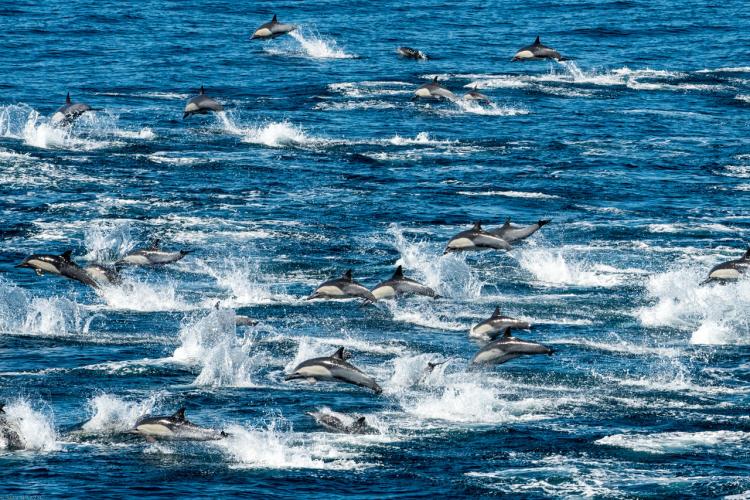Population assessments are a key component of marine resource management. These assessments allow us to evaluate and report the status of managed fisheries, marine mammals, and endangered/threatened species under the authorities of the Magnuson-Stevens Fishery Conservation and Management Act, the Marine Mammal Protection Act, and the Endangered Species Act.
To conduct population assessments, our scientists:
- Collect data and information
- Analyze results through quantitative methods
- Hold peer review
- Communicate results to our partners and stakeholders
The assessment process uses current data and advanced analytical techniques in an effort to provide the best scientific information available for conservation and management decisions. They are critical to ensuring the health of protected stocks and the availability of sustainable seafood.
A variety of data are input into computer models to estimate population size and trends for fish, marine mammals, marine turtles, and krill, generating a stock assessment report. Research surveys provide biological, ecological and environmental data. Commercial fisheries provide logbook and landings data which indicate quantity and weight, among other characteristics, of catches. Independent fishery observers also collect information on commercial fisheries catches.
Marine Mammal Assessments
NOAA Fisheries annually prepares marine mammal stock assessment reports for each species by region: Alaska, U.S. Atlantic Ocean/Gulf of America, and U.S. Pacific Ocean. View information on the current U.S. Pacific Marine Mammal Stock Assessment Report, past reports, and reports from other regions.
Highly Migratory Species Assessments
Stock assessments for highly migratory species (tunas, sharks, tuna-like species whose ranges span the waters of multiple nations) are conducted under the auspices of international organizations, Inter-American Tropical Tuna Commission, International Scientific Committee for Tuna and Tuna-Like Species in the North Pacific Ocean (ISC), and Western and Central Pacific Fisheries Management Commission. NOAA Fisheries actively participates in ISC assessments and reviews others and the assessments are used to make domestic status determinations. The Pacific Fishery Management Council maintains the Highly Migratory Species Stock Assessment and Fishery Evaluation (SAFE) document, which contains links to the most recent stock assessment reports from these organizations.
Coastal Pelagic Species Assessments
Southwest Fisheries Science Center scientists conduct assessments on Pacific sardine, northern anchovy, and Pacific mackerel for the Pacific Fishery Management Council which maintains a list of current Coastal Pelagic Species stock assessment reports.
Groundfish Assessments
Southwest Fisheries Science Center scientists conduct groundfish assessments every other year for the Pacific Fishery Management Council. The Council maintains a list of current groundfish stock assessment reports.
Salmon Assessments
Salmon have a complex life history. Anadromous fish, they are born in freshwater and migrate to the oceans where they spend most of their lives, returning to their natal streams to breed and die. This complex life history means they are affected by a broad range of impacts from land to sea - agriculture, dams, fisheries, pollution, and more. This makes analyzing and managing the fisheries equally complex. The Pacific Fishery Management Council maintains a list of current salmon stock assessment documents.
Antarctic Assessments
Our staff participate in the Commission for the Conservation for Antarctic Marine Living Resources (CCAMLR) and conduct assessments of Antarctic finfish fisheries and krill. These assessments are used by CCAMLR to set Antarctic fishery catch levels for CCAMLR members. Fishery reports are available for Antarctic toothfish, Patagonian toothfish, Antarctic krill and mackerel icefish.
West Coast Marine Turtle Assessments
Sea turtles’ long lifespans, dependence on both beach and in-water habitats, and often wide-ranging migrations make them difficult to monitor and susceptible to many threats. All sea turtle species that occur in the United States are protected under the Endangered Species Act and have been listed under the Act since the 1970s. Globally, many nesting populations are believed to be at a fraction of historic levels. NOAA Fisheries has lead responsibility for sea turtles in the marine environment.
Sea turtle assessments inform ESA processes and ecosystem management and aid NOAA Fisheries' evaluation of the nation’s progress in reducing impacts of fisheries on protected species. Regular population assessments are necessary to measure progress toward sea turtle recovery goals under the ESA and to provide the foundation for evaluating management activities. Data-rich assessments not only help NOAA Fisheries work toward its own goals and responsibilities but likely benefit other agencies and stakeholders by providing a solid foundation for evaluation and permitting of specific anthropogenic activities. Baseline data are also important for developing response plans for and evaluating the population and ecosystem impacts of catastrophic events.



